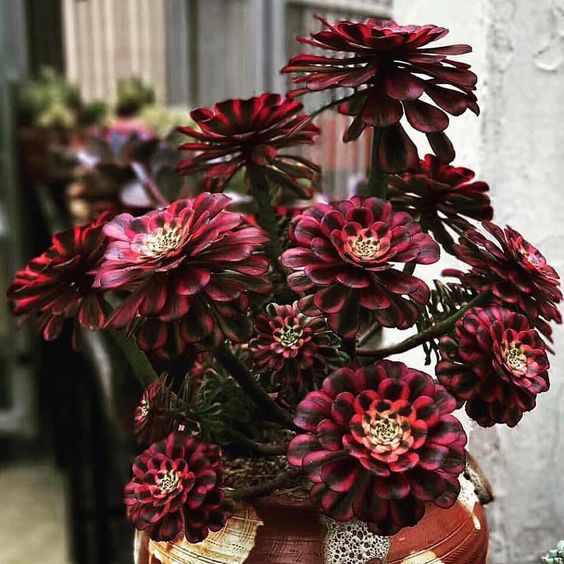This Aeonium is vibrant and its leaves are multi-colored. When exposed to direct sunlight or cooler climates, the stripes of yellow and green turn pink and lime green.
Table of Contents
Care and Propagation Information
Aeonium ‘Mardi Gras’ is an ideal choice for outdoor gardens, both planted in the ground or in pots. This variety of Aeonium is named after the vibrant Mardi Gras celebration, and is a cross between Aeonium ‘Velour’ and another Aeonium species.
Watering
Aeonium ‘Mardi Gras’ requires typical succulent care, so it’s best to use the “soak and dry” method. This means that the soil should be completely dry before watering again.
Where to Plant
If you live in an area with temperatures that dip below 20°F, it’s best to grow Mardi Gras in a pot so that you can bring it indoors during cold weather. This succulent thrives in either full or partial sunlight.
How to Propagate Aeonium ‘Mardi Gras’
You can propagate Aeonium ‘Mardi Gras’ by taking stem cuttings or leaves, with stem cuttings being more likely to be successful.
Cuttings
To propagate ‘Mardi Gras’ from cuttings, take a clean, sharp knife or pair of scissors and snip off a stem from the main plant. Let the cut end scab over for a few days before planting it in soil that drains well. Be sure to water the cuttings only when the soil has completely dried out.
Leaves
To propagate ‘Mardi Gras’, carefully remove a single leaf from the mother plant and twist it off the stem. Ensure that no part of the leaf remains attached, as this will decrease the chances of successful propagation.
Let the leaf sit for a few days until the end is sealed, then place it on soil that drains well. Water only when the soil is completely dry.
Care and Propagation Information
General Care for Aeonium ‘Mardi Gras’
Watering
Aeonium ‘Mardi Gras’ requires typical succulent care, so it’s best to use the “soak and dry” method. This means that the soil should be completely dry before watering again.
Where to Plant
If you live in an area with temperatures that dip below 20°F, it’s best to grow Mardi Gras in a pot so that you can bring it indoors during cold weather. This succulent thrives in either full or partial sunlight.
How to Propagate Aeonium ‘Mardi Gras’
You can propagate Aeonium ‘Mardi Gras’ by taking stem cuttings or leaves, with stem cuttings being more likely to be successful.
Cuttings
To propagate ‘Mardi Gras’ from cuttings, take a clean, sharp knife or pair of scissors and snip off a stem from the main plant. Let the cut end scab over for a few days before planting it in soil that drains well. Be sure to water the cuttings only when the soil has completely dried out.
Leaves
To propagate ‘Mardi Gras’, carefully remove a single leaf from the mother plant and twist it off the stem. Ensure that no part of the leaf remains attached, as this will decrease the chances of successful propagation.
Let the leaf sit for a few days until the end is sealed, then place it on soil that drains well. Water only when the soil is completely dry.
FAQ
How do you keep aeonium over winter?
You can give your aeonium a diluted plant food once a month from winter to late spring. Aeoniums are not frost tolerant, but they can tolerate cooler temperatures as long as the soil is not wet. To ensure their safety, try not to let it drop below 5°C.
How tall does Aeonium Mardi Gras grow?
Soil Requirements Organic-rich, well-drained soil
How do you grow aeonium Mardi Gras?
Keep the soil moist but not wet and in a couple of weeks you should have a new Mardi Gras plant growing.
To propagate Mardi Gras, twist a leaf off of the mother plant, making sure that none of the leaf remains on the stem. Allow the leaf to dry out for a few days until the end is slightly calloused. Plant the leaf on soil that drains well, ensuring that the soil is kept moist but not wet. In a few weeks, you should see a new Mardi Gras plant emerging.
Why are the leaves falling off my aeonium?
Do Aeoniums lose their leaves in winter?
During dormancy, Aeonium plants will shed their basal leaves that line the stem of the plant, forming a tight and compact rosette shape, as seen in the picture of Aeonium undulatum (pictured left). The remaining leaves will be closely held together.



